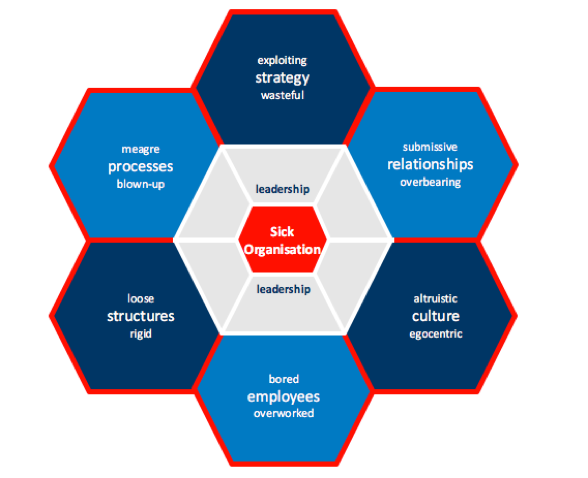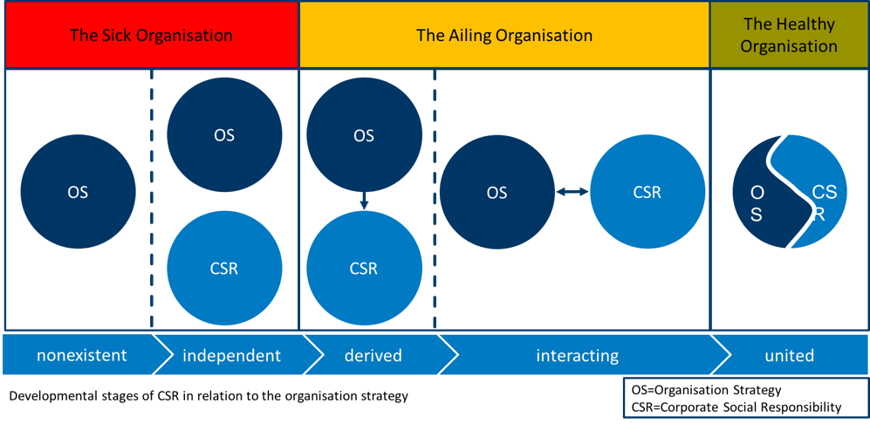The Sick Organisation: how sick is your strategy (SO 2/7)?
The second part of the series on the Ailing (AO) or Sick Organisation (SO) deals with “incorrect“ strategies of a company. In the following article you will find out what makes a strategy sick, how this can be determined and, on the other hand, how you can be ahead of time and develop competitive benefits.
If a strategy becomes sick, we call it exploiting or wasteful. Both forms illustrate the negative poles of a market- and resource-oriented and thus future-proof approach (refer to Fig. 1, The Sick Organisation). The different developmental stages in the integration of Corporate Social Responsibility (CSR) in the organisational strategy show that it can work differently.

Fig.1: The Sick Organisation
The following brief example shall illustrate this:
Imagine you are employed in the management of an online trading company. Over the last months you have consequently analysed and come to the conclusion that other websites are being significantly more frequented and are increasing their market share, while sales in your company are stagnating and even slightly going back.
What will you do?
You will improve your offer. If others are better, then in your sector the reason for this usually is that others have a broader range of products, less expensive products or more exclusive articles. The logical step would therefore be to perform benchmarking. On the basis of your analysis you find out that most other online retailers have more attractive websites and offer more modern brands. Therefore, you decide to invest in these two fields in particular.
But wait! Although you now know more about your competitors, how well do you know your own company and your customers? Maybe your customers like your website and your offer after all. The comparison with the competitors alone will not be enough to understand a symptom. Maybe the customer service you are offering is insufficient or the delivery of your customer orders is often delayed. Or maybe the accessibility by phone is poor, the telephone staff is unfriendly or knows too little about the products (keyword “cheap labour“). Or there is information missing on your website with regard to where and how the products are being made and how important the subjects of sustainability and fair trade (keyword “CSR“) are to you.
Instead of making a wrong decision too fast, you should reflect from different perspectives. In the example above in particular from the customer perspective. What are the trends on the market? What do your customers think and want? How can you exceed customer expectations? Think in a cross-linked manner, considering the interactions that could develop by means of your strategy. A strategy serves as a long-term orientation of a company. It should be able to answer the following questions: Why does our company exist at all and what is its purpose? Where do we want to get - what is our idea for the future? How do we want to act - which practices should help us in doing so?
Actually, you can observe in many companies how exploiting or wasteful strategies incorrectly align the company and - in the worst case - make it incompetitive in the long term. Consider Schlecker, the case of VW with the Dieselgate affair, whose consequences are not yet foreseeable or most recently the dividend methods of the Commerzbank (keyword “Cum-Cum-Deals“). Last of which might possibly be legal, but it leaves a bad taste nevertheless. Often you can observe in practice that the responsible people are having a hard time formulating and critically reflecting their own company strategy. The solution is then often called growth. But how? At any price? Growth essentially is positive, but not at any price. Strategies with the sole focus on profit maximisation at the expense of the ecological and social responsibility we therefore callexploiting.
However, the opposite can sicken as well. As exploiting strategies we understand concepts, in which company resources or natural resources are treated too carelessly. This can range from a lax handling of travel costs, over the unnecessary waste of energy resources up to an inadequate utilisation of employee potential. From this ailing condition a sick organisation can develop in particular when towards the outside the corporate social responsibility is conjured up in high-gloss films, while the practiced organisation methods look completely different. Employees recognise these contradictions and identify themselves less and less with the company. In an increasingly networked, digitalised and transparent world, in which there are a lot of whistle-blowers, it is just a matter of time until such practices emerge to the outside, thus endangering thecredibility and reputation on the market. In case of doubt it can take an impaired reputation a long time to recover - something that we know from the quality deficits at jaguar in the 60s.
Studies (Rivoli & Waddock, 2011) show that CSR is situated in a time-context-dynamic, in which the understanding of CSR is expanding continuously. What was responsibly new yesterdayis a standard today and an expectation tomorrow. Companies that are today already acting more responsible than the regulative standards prescribe, are setting new standards that in turn become a new standard by means of an institutionalisation process. Healthy Organisations thus not only have a competitive advantage, but they can also influence their context, lead their competitors to more responsibility, and, thus, expand the social and political understanding of responsibility.
In Figure 2 you can see how entrepreneurial responsibility can contribute to a societal consciousness development. In the figure it becomes clear that in SO a corporate social responsibility is either not integrated at all in the organisation strategy or it exists completely independent of it. With these dissociated CSR initiatives the companies only lead their customers to believe in a responsible company character. This relatively wide spread behavior is also being called green-washing.

Figure 2: Developmental steps of strategic corporate social responsibility in organisations
In AO CSR is at least treated strategically. The entrepreneurial responsibility is derived from organisational strategies. This leads to the fact that companies operate senseful, enterprise-related and strategy-oriented initiatives. Projects are supported and processes optimised that are related with the actual value-added chain. However, responsibility here as well is being practised more in marketing terms or on grounds of conscience, in order to possibly make up for unresponsible actions. Still not optimal, but already advanced is the developmental stage in which CSR and organisation strategy are interacting and CSR has an actual effect on strategy development. This means that already from the beginning of shaping company processes and projects a responsible treatment of humans and nature is being respected. Organisations on this developmental stage see CSR no longer as a marketing instrument, but as a strategy elementand live responsibility as a corporate value.
In HO strategy and responsibility are united, the strategy of a company is implicitly based onresponsible principles. Actually, one no longer would have to speak of CSR in the final developmental stage, since it is no longer treated as an independent element. In fact, strategy simultaneously implies social and ecological responsibility. Partly Healthy Organisations do not market their responsibility, since they and their stakeholders, including the customers, are aware of the responsible principles and practices of the company and responsibility does not have to be treated as an explicit factor.
To get to the heart of it at the end: It is not about being more Catholic than the Pope. To fulfill everything to 100% and to be completely politically correct will be hard to realise in daily business. We are all human, all humans are different and make mistakes. They do not want to be squeezed in a straightjacket. Practicable should be a balanced strategy, in which CSR is completely integrated and which thus faces its different stakeholder groups in a serious and credible manner and satisfies them. This alone is really competitive and sustainable.

